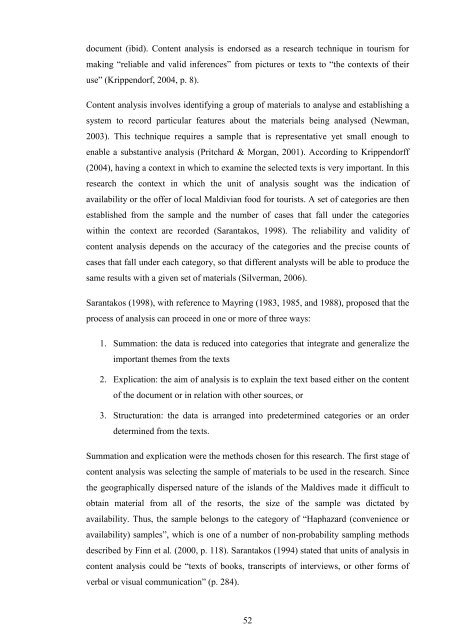The Role of Local Food in Maldives Tourism - Scholarly Commons ...
The Role of Local Food in Maldives Tourism - Scholarly Commons ...
The Role of Local Food in Maldives Tourism - Scholarly Commons ...
Create successful ePaper yourself
Turn your PDF publications into a flip-book with our unique Google optimized e-Paper software.
document (ibid). Content analysis is endorsed as a research technique <strong>in</strong> tourism for<br />
mak<strong>in</strong>g “reliable and valid <strong>in</strong>ferences” from pictures or texts to “the contexts <strong>of</strong> their<br />
use” (Krippendorf, 2004, p. 8).<br />
Content analysis <strong>in</strong>volves identify<strong>in</strong>g a group <strong>of</strong> materials to analyse and establish<strong>in</strong>g a<br />
system to record particular features about the materials be<strong>in</strong>g analysed (Newman,<br />
2003). This technique requires a sample that is representative yet small enough to<br />
enable a substantive analysis (Pritchard & Morgan, 2001). Accord<strong>in</strong>g to Krippendorff<br />
(2004), hav<strong>in</strong>g a context <strong>in</strong> which to exam<strong>in</strong>e the selected texts is very important. In this<br />
research the context <strong>in</strong> which the unit <strong>of</strong> analysis sought was the <strong>in</strong>dication <strong>of</strong><br />
availability or the <strong>of</strong>fer <strong>of</strong> local Maldivian food for tourists. A set <strong>of</strong> categories are then<br />
established from the sample and the number <strong>of</strong> cases that fall under the categories<br />
with<strong>in</strong> the context are recorded (Sarantakos, 1998). <strong>The</strong> reliability and validity <strong>of</strong><br />
content analysis depends on the accuracy <strong>of</strong> the categories and the precise counts <strong>of</strong><br />
cases that fall under each category, so that different analysts will be able to produce the<br />
same results with a given set <strong>of</strong> materials (Silverman, 2006).<br />
Sarantakos (1998), with reference to Mayr<strong>in</strong>g (1983, 1985, and 1988), proposed that the<br />
process <strong>of</strong> analysis can proceed <strong>in</strong> one or more <strong>of</strong> three ways:<br />
1. Summation: the data is reduced <strong>in</strong>to categories that <strong>in</strong>tegrate and generalize the<br />
important themes from the texts<br />
2. Explication: the aim <strong>of</strong> analysis is to expla<strong>in</strong> the text based either on the content<br />
<strong>of</strong> the document or <strong>in</strong> relation with other sources, or<br />
3. Structuration: the data is arranged <strong>in</strong>to predeterm<strong>in</strong>ed categories or an order<br />
determ<strong>in</strong>ed from the texts.<br />
Summation and explication were the methods chosen for this research. <strong>The</strong> first stage <strong>of</strong><br />
content analysis was select<strong>in</strong>g the sample <strong>of</strong> materials to be used <strong>in</strong> the research. S<strong>in</strong>ce<br />
the geographically dispersed nature <strong>of</strong> the islands <strong>of</strong> the <strong>Maldives</strong> made it difficult to<br />
obta<strong>in</strong> material from all <strong>of</strong> the resorts, the size <strong>of</strong> the sample was dictated by<br />
availability. Thus, the sample belongs to the category <strong>of</strong> “Haphazard (convenience or<br />
availability) samples”, which is one <strong>of</strong> a number <strong>of</strong> non-probability sampl<strong>in</strong>g methods<br />
described by F<strong>in</strong>n et al. (2000, p. 118). Sarantakos (1994) stated that units <strong>of</strong> analysis <strong>in</strong><br />
content analysis could be “texts <strong>of</strong> books, transcripts <strong>of</strong> <strong>in</strong>terviews, or other forms <strong>of</strong><br />
verbal or visual communication” (p. 284).<br />
52

















